Thrown into this city as a result of a choice in University, I have always felt like I existed in a sub-part of Leeds. One categorised by Student Union pints, terrible club nights and the Brotherton library. This year, I wanted things to be different. I made a vow to exist as a young person in the city, not just a student.
This is how I found myself in ‘The Colour of Anxiety’ at the Henry Moore Institute. Art has always grounded me in space and offers me a profound insight into how a city or town presents itself.
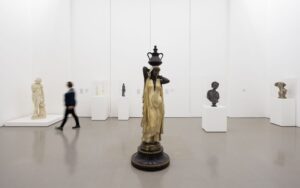
Installation view of ‘The Colour of Anxiety’. Photo: Rob Harris. (Image from the Henry Moore Institute‘s website)
The exhibition, which aimed to investigate ‘Race, Sexuality and Disorder in Victorian Sculpture’ asks: How did the Victorians work to define femininity and colour within their artwork? How is this reflecting the turbulent context within which the work was produced? Already relevant and thought provoking from the opening title, I was hooked.
The journey starts with Hiram Powers’ ‘Greek Slave’ in a room showcasing ‘The Hope Venus to the Tinted Venus’. This sculpture depicts a white woman being sold at an Ottoman slave market. Although beautifully crafted, it is classical. This is something we’ve seen numerous times before: a perfectly proportioned nude woman, gazing into the distance, her flawless figure etched in white marble. And yet, the shackles around her wrist add an ominous undertone to the sculpture.
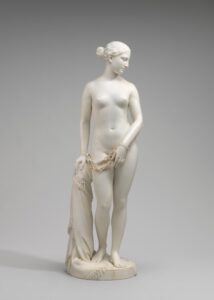
‘The Greek Slave’, Hiram Powers, material: Seravezza marble, model 1841-1843, carved 1846. Credit: Corcoran Collection (Gift of William Wilson Corcoran)
This woman is not free. It evokes connotations of women as slaves, not just in the Ottoman empire, but in a different way within Victorian society. Particularly relating to how men viewed women. Further enforced by the painting hanging on the wall immediately behind it, G.F Watts’ ‘Found Drowned’, depicting a woman washed up on a beach – dead. Exposing the raw underbelly of Victorian England. The duality of women being simultaneously a chaste, powerless angel of the house and the lowly, degenerate woman of the night.
Moving on, the second room highlighted the rise of colour in late Victorian sculpture. A trope previously unknown to me until stumbling into this exhibition. The increased use of colour at this time had previously been attributed to a perceived renewed interest in medieval craftsmanship. However, here the exhibit attempted to situate this use of colour within the context of Victorian England society.
Questions around women as both seductress and mother, which had been explored in the opening room, now also included questions of race. The male ‘artist’s fantasy of the ideal woman and fears about her powers to destroy him’ were beginning to include women of colour.
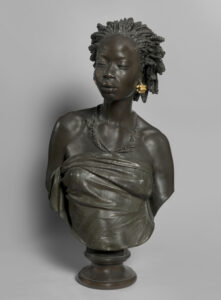
Vénus africaine, Charles Codier, 1852, material: Bronze. (Image from Royal Collection Trust‘s website)
My mouth fell open, agog, locking eyes with Charles Cordier’s ‘Venus Africane.’ After years of studying and consuming art, this was one of the few times I had come across a figurative sculpture of colour. The beautifully carved bust depicts a black woman, face blank and lips pursed, her gold earrings standing starkly against the plaster of her skin. I was both awestruck and unnerved by the sculpture.
Partnered with other work by Cordier in the room; the work insinuated both a statement against the institutions of slavery and colonisation, and also the tools of fetishization and sexualisation coming from these institutions. It is hard to consume the work of white male Victorian artists without criticising the ideals and objectives which may have fuelled their practice, inherent within their society.
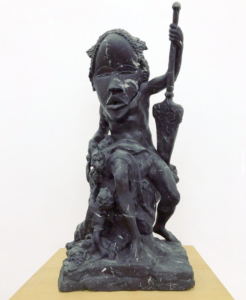
NILE, Sanford Biggers, 2021, Material: Black marble, at the Henry Moore Institute.
Towards the back of the room another piece stuck out. A black marble sculpture depicting the body of a man, as you would find in any classical art gallery, topped with a head in the form of an African mask. This fusion of classical figurative sculpture with mythologies and traditions of Africa worked to challenge ingrained biases towards European classic forms in it’s traditional form. The artist, Sanford Biggers, asks why we regard some art as more prestigious than others and aims to redraw the boundary. This felt urgent and innovative. The sculpture stuck with me long after I’d left the exhibition.
The final room of the exhibition drew together depictions of ‘deathly women’ investigating a common trope in Victorian England of depicting ‘seductive women’. This coupled with all the depictions of women I had seen in previous rooms left me reeling with questions of what it meant to be a woman. Contemplating how so many of the ideas of women explored in the work of Victorian England were ideas still floating around today. The woman as a seductress. As the root of evil. As a figure of beauty. As a slave. As a prostitute. As a mother. As a virgin.
However, I found myself annoyed at the bigger question underpinning my experience at this exhibition. Why was I only now, in 2023, learning about an albeit small, but significant part of cultural arts practises in Victorian England. And why do questions of race in art and in England feel like such a new topic when they have been happening for centuries? Ongoing problems which never seem to be met with solutions.
But this exhibition at the Henry Moore Institute is working to answer these questions. Shedding light on a part of art history not seen before, rewriting the status quo at a time when it has never been more necessary, or overdue.
***

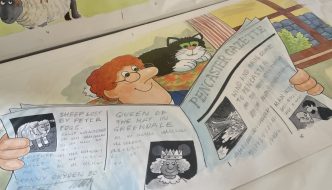


Comments